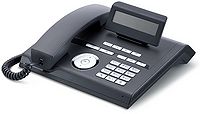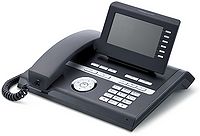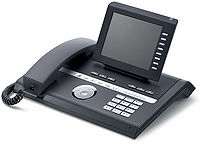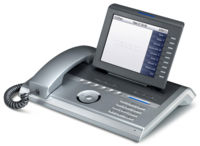Difference between revisions of "OpenStage SIP"
The Wiki of Unify contains information on clients and devices, communications systems and unified communications. - Unify GmbH & Co. KG is a Trademark Licensee of Siemens AG.
(→Phone range) |
(→{{en}} English) |
||
| Line 207: | Line 207: | ||
* {{File-DL|Datasheet OpenStage SIP|pdf}} | * {{File-DL|Datasheet OpenStage SIP|pdf}} | ||
| + | * {{File-DL|Quick Reference Guide OpenStage 20 SIP|pdf}} | ||
| + | * {{File-DL|Quick Reference Guide OpenStage 40 SIP|pdf}} | ||
* {{File-DL|Quick Reference Guide OpenStage 60-80 SIP|pdf}} | * {{File-DL|Quick Reference Guide OpenStage 60-80 SIP|pdf}} | ||
* {{File-DL|User Manual OpenStage 20 SIP|pdf}} | * {{File-DL|User Manual OpenStage 20 SIP|pdf}} | ||
Revision as of 08:42, 18 September 2007

|

|
| OpenStage 20 | OpenStage 40 |

|

|
| OpenStage 60 | OpenStage 80 |
The OpenStage phone family consists of four SIP phones:
OpenStage 20, OpenStage 40, OpenStage 60 and OpenStage 80.
Contents
Phone range
The OpenStage family have a wide common feature set (listed below) and additional features per model (specified for each phone model).
- Standard based SIP support according to RFC 3261
- Power over Ethernet (PoE) IEEE 802.3af or external power supply (EU, US and UK power adapters)
- Computer Telephony Integration (CTI) / Third party call control
- Remote administration via Web-based management, HiPath Deployment Service or XML files
- Supported Codecs:
- Full-duplex hands-free talking
- 2 ports 10/100Base-T built-in Ethernet switch
- Tiltable display
- USB support (OpenStage 60 and OpenStage 80)
- Bluetooth support (OpenStage 60 and OpenStage 80)
- Built-in applications:
- Graphical call handling
- Local Telephone book
- Directory access (LDAP) (OpenStage 60 and OpenStage 80)
- Call log / history
- Help
- External applications integrated into phone user interface:
- XML API (OpenStage 60 and OpenStage 80; coming soon)
- JAVA VM (OpenStage 60 and OpenStage 80; coming soon)
- SDK Software Development Kit (OpenStage 60 and OpenStage 80; coming soon)
- Free programmable sensorkeys
- TouchGuide for navigation and feature control (OpenStage 60 and OpenStage 80)
- TouchSlider for volume settings (OpenStage 60 and OpenStage 80)
- Keypad with 12 keys
- Increasing combination of various housing colors and materials from model to model (ice blue, lava, silver blue metallic)
Display
| Tiltable Display | OpenStage 20 | OpenStage 40 | OpenStage 60 | OpenStage 80 |
|---|---|---|---|---|
| Technology | LCD | LCD | TFT | TFT |
| Color | Monochrome | Monochrome | 16 bit depth | 16 bit depth |
| Size | 205x41 pixel | 240x128 pixel | 320x240 pixel (QVGA) | 640x480 pixel (VGA) |
| Diagonal | N/A | 5.1" | 5.7" | 6.4" |
| Lines | 2 (24 characters) | 6 (Graphics) | Graphics | Graphics |
| Backlit | No | Yes | Yes | Yes |
Keys/LEDs
| Keys and LEDs features | OpenStage 20 | OpenStage 40 | OpenStage 60 | OpenStage 80 |
|---|---|---|---|---|
| Fixed function keys (Pushbuttons) | 7 (5 red LEDs)[1] | 8 (6 red LEDs)[1] | 6 (5 blue LEDs)[1] | 6 (5 blue LEDs)[1] |
| Freely programmable touch keys | 0 | 6 (red LEDs)[2] | 8 (blue LEDs)[2] | 9 (blue LEDs)[2] |
| Mode keys (touch keys) | 0 | 0 | 6 (blue LEDs)[3] | 6 (blue LEDs)[3] |
| Optical call alert | No | Red LED | Blue LED | Blue LED |
| Volume adjustment | via +/- keys | via +/- keys | via TouchSlider[4] | via TouchSlider[4] |
| Navigation element | 3 Ways navigator | 5 Ways navigator | TouchGuide | TouchGuide |
Interfaces
| OpenStage 20 | OpenStage 40 | OpenStage 60 | OpenStage 80 | |
|---|---|---|---|---|
| Bluetooth V2.0 | No | No | Yes | Yes |
| Headset jack (121 TR9-5) | No | Yes | Yes | Yes |
| USB Master | No | No | Yes | Yes |
The telephony application provides a set of features and the connectivity to a set of SIP systems (proxies, application servers)
- General overview on platforms / systems:
| Platform | Comment | Details |
|---|---|---|
| HiPath 8000 | IP-Softswitch | V2.2 |
For detailed interoperability information please check Software version and Interoperability sections on this page.
Connectivity to several VoIP providers is supported.
For configuration hints see the How To article.
Documentation
All OpenStage phones are shipped with a printed document (![]() QRG OpenStage ML) providing brief instruction regarding installation and operation.
For both user and administrators, a comprehensive and updated documentation is provided as PDF files.
QRG OpenStage ML) providing brief instruction regarding installation and operation.
For both user and administrators, a comprehensive and updated documentation is provided as PDF files.
|
 English
English
-
 Datasheet OpenStage SIP
Datasheet OpenStage SIP -
 Quick Reference Guide OpenStage 20 SIP
Quick Reference Guide OpenStage 20 SIP -
 Quick Reference Guide OpenStage 40 SIP
Quick Reference Guide OpenStage 40 SIP -
 Quick Reference Guide OpenStage 60-80 SIP
Quick Reference Guide OpenStage 60-80 SIP -
 User Manual OpenStage 20 SIP
User Manual OpenStage 20 SIP -
 User Manual OpenStage 40 SIP
User Manual OpenStage 40 SIP -
 User Manual OpenStage 60-80 SIP
User Manual OpenStage 60-80 SIP -
 Administration Manual OpenStage HiPath 8000
Administration Manual OpenStage HiPath 8000
 Deutsch
Deutsch
-
 Datenblatt OpenStage SIP
Datenblatt OpenStage SIP -
 Kurzanleitung OpenStage 60-80 SIP
Kurzanleitung OpenStage 60-80 SIP -
 Bedienungsanleitung OpenStage 20 SIP
Bedienungsanleitung OpenStage 20 SIP -
 Bedienungsanleitung OpenStage 40 SIP
Bedienungsanleitung OpenStage 40 SIP -
 Bedienungsanleitung OpenStage 60-80 SIP
Bedienungsanleitung OpenStage 60-80 SIP
Web Based Training
Try out the Web Based Training for OpenStage 40 and OpenStage 60/80 telephones.
- Run the WBT online:
- OpenStage 40 SIP:
 Run WBT -
Run WBT -  WBT starten
WBT starten - OpenStage 60/80 SIP:
 Run WBT -
Run WBT -  WBT starten
WBT starten
- OpenStage 40 SIP:
- Download the WBT for local use:
- OpenStage 40 SIP:
 Download WBT -
Download WBT -  WBT herunterladen (25MB ZIP file)
WBT herunterladen (25MB ZIP file) - OpenStage 60/80 SIP:
 Download WBT -
Download WBT -  WBT herunterladen (40MB ZIP file)
WBT herunterladen (40MB ZIP file)
- OpenStage 40 SIP:
Firmware / Software
The SIP firmware provides encryption capabilities. Hence its distribution must follow legal requirements which do not allow unrestricted SW distribution via the Internet. The firmware is only provided by Siemens technicians or by official Siemens Partners. Customers with self-care contracts will have access to SW within the SEBA Web portal (login required).
The Application software of the OpenStage SIP phones can be transferred to the phone:
- using FTP or HTTPS method.
- using Deployment Service (HiPath DLS V1 R2.21.0 necessary).
- using WBM phone interface (OpenStage SIP V1.0 need the Application software V1 R0.3.1).
Current software releases
The actual Application software is OpenStage 20/40/60/80 SIP V1 R2.5.10.
| Version | Release | Release date | Release note |
|---|---|---|---|
| V1 | R2.5.10 | 31/08/2007 | OpenStage 20/40/60/80 SIP V1 R2.5.10 |
| V1 | R0.12.2 | 15/06/2007 | OpenStage 60/80 SIP V1 R0.12.2 |
| V1 | R0.11.0 | 21/05/2007 | OpenStage 60/80 SIP V1 R0.11.0 |
| V1 | R0.10.0 | 30/04/2007 | OpenStage 60/80 SIP V1 R0.10.0 |
| V1 | R0.9.008 | 12/04/2007 | OpenStage 60/80 SIP V1 R0.9.008 |
| V1 | R0.8.13 | 09/03/2007 | OpenStage 60/80 SIP V1 R0.8.13 |
| V1 | R0.7.92 | 26/02/2007 | OpenStage 60/80 SIP V1 R0.7.92 |
| V1 | R0.4.0 | 22/12/2006 | OpenStage 60/80 SIP V1 R0.4.0 |
To get an overview of all release notes for the OpenStage SIP family see the history of all Release Notes.
Interoperability Matrix
For detailed interoperability information please check OpenStage SIP interoperability matrix.
OpenStage Manager
The OpenStage Manager is a comprehensive and powerful tool for your OpenStage 60 and OpenStage 80 telephone. The main function of the OpenStage Manager is to serve as an interface between your phone and PC, thus enabling convenient phonebook editing on your PC. OpenStage Manager allows you to synchronize contacts in Microsoft Outlook with the contacts in your telephone.
Mass deployment
What do we mean with “deployment”?
The installation of an IP phone in general requires integrating the phone into an IP infrastructure specific to the customer’s or user’s needs. This integration normally requires some activities on all components involved, i.e. on the IP phone and on other components like application servers and routers.
Additionally to the hardware related tasks like providing LAN cables and setting up the necessary power supply, this integration also covers adapting the IP phone to the individual customer configuration by setting various parameters to appropriate values. In this article we will use the term “deployment” for this task, including the provisioning of new software to the IP phone. Sometimes the term “provisioning” is used instead of “deployment”.
Individual phones can be easily set up using the local menue and the keypad or - more comfortable and even remotely - the phone's web administration. Larger companies or voice service providers have to install and maintain hundreds or thousands of phones, requiring mass deployment capabilities.
Mass deployment – how it works
IP terminals offer a range of functions and characteristics that were unknown or technically impossible in analog or early digital system environments (for example, ISDN). But increased product flexibility requires more complex technology. For this reason, it is essential that VoIP devices be optimally configured for users while at the same time expenditure (costs, time, training) must be kept to a minimum for service providers. Different scenarios have different requirements. However the following factors are critical for all solutions:
- Minimum network intervention or modification
- No inflexible or costly preconfiguration at the terminal
- No or minimum (one-off) user activities
There are two main scenarios:
- Using the HiPath DLS see DLS Mass Deployment or
- using (XML-) configuration files.
Add-On devices, Adapters and Accessories
Headsets
The following headsets could be used with OpenStage 40, 60 and 80 phones:
Plantronics headsets:
- Single earpiece (monaural, sound in one ear) headset style:
- with noise canceling microphone
- H141N DuoSet
- H91N Encore
- P91N Encore Polaris
- H51N Supra
- with lightweight voice tube microphone style
- H141 DuoSet
- H91 Encore
- P91 Encore Polaris
- H51 Supra
- with noise canceling microphone
- Double earpiece (binaural, sound in both ears) headset style:
- with noise canceling microphone
- H101N Encore
- H61N Supra
- with lightweight voice tube microphone style
- H101 Encore
- H61 Supra
- with noise canceling microphone
and Plantronics in-the-ear single earpiece (monaural, sound in one ear) wearing style:
- with noise canceling microphone
- H81N TriStar
- P81N TriStar Polaris
- with lightweight voice tube microphone style
- H81N TriStar
- P81 TriStar Polaris
Plantronics Polaris headsets series are for use with phone systems with built-in amplifiers.
GN Netcom headsets:
- Profile
- Profile binaural
It’s generally recommended to use 8 poles connectors.
Further headsets may be available from other vendors: the main key criteria is the full compliance with 121-TR9-5 (corded) or 121-TR9-5* (cordless) standards.
See also
- OpenStage - the portal page of the OpenStage telephone family
- OpenStage Training - easy learning to use your feature-rich enterprise phone
- OpenStage Manager - feature description of the PC application for OpenStage
- OpenStage power supply and PoE classes - required power supply and PoE classes of phones and accessories
- OpenStage Hardware Changes and necessary Software Versions - comparative table of supported hardware versions
- OpenStage Bluetooth - OpenStage 60/80 Bluetooth feature information
- OpenStage Accessories - Add-On devices, Adapters and Accessories
- OpenStage Main Navigation - comparative information about the main navigation elements
External links
- You can visit the OpenStage Tour from the SIEMENS Enterprise web site.
- You can read the SIEMENS Open Communications News Press Release (December 2006) about the released OpenStage family of SIP phones.
- You can have a look to the whole SIP terminal devices families on www.siemens.com/enterprise web site.
- Siemens won the iF product design award 2007 for its OpenStage phone, OpenStage was awarded at iF awards ceremony of iF product design award 2007 during CeBIT fair last 15.03.2007 in Hannover.




